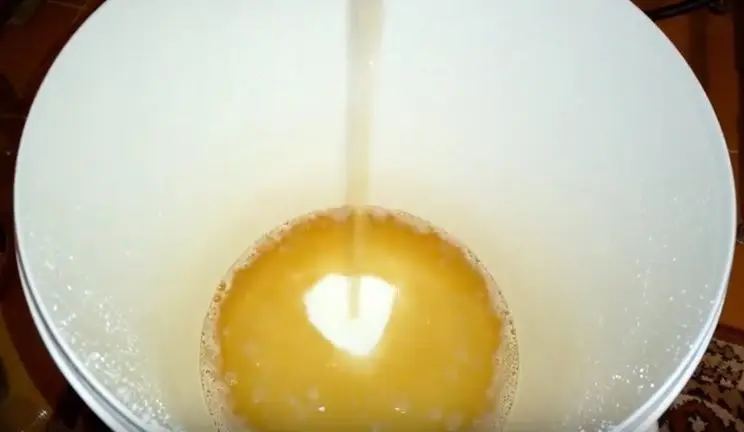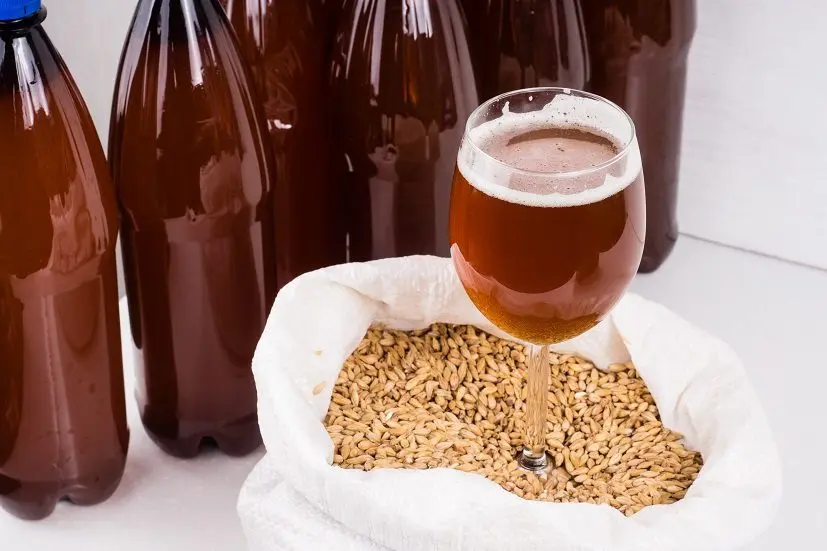Weissbier is a wheat beer of the Bavarian royal court, which became available to the general public only in 1872. It is a golden-colored pale ale with a strength of 4-6% vol. with characteristic clove and banana tones from Munich brewer’s yeast. We will look at the full technology and the classic recipe for unfiltered wheat beer, which is maximally adapted for home conditions.
Of the mandatory equipment, a brewing vessel of at least 30-35 liters is required, an electronic thermometer for accurate temperature control, a fermentation tank with a water seal, 3 cans (2 three-liter and one half-liter) with metal lids and bottles for pouring finished beer.
In the process of work, the hands must be perfectly clean, otherwise you can accidentally infect the wort, spoiling the entire batch of the drink. Steam sterilization and iodine disinfection are optional but highly recommended.
Ingredients for 25 liters of wheat beer:
- Pilsen malt – 3 kg;
- wheat malt – 2 kg;
- Munich (Munich) malt – 0,7 kg;
- yeast Danstar Munich (Danstar Munich) – 11 grams;
- Hallertau Blanc hops – 14 grams (for bitterness);
- hop Sapphire (Saphir) – 14-20 grams (for aroma);
- water – 32 liters.
Wheat beer recipe
1. Mix and grind the malt (if purchased not ground).
2. Heat 22 liters of water in a brewing vessel to 52 °C, add malt. Mix until smooth.
3. Heat the wort to 65°C. Maintain the temperature in the range of 64-66 °C for 40 minutes, stirring the wort from time to time so that the malt does not burn near the bottom.
4. Heat the wort to 72 °C, maintain the indicated temperature for 25 minutes.
5. Raise the temperature to 78 ° C, cook for 15 minutes.
6. In a separate container, heat 10 liters of water to 78 °C (rinsing water).
7. Remove the wort from the stove. Filter through any filtration system so that the malt residues are collected in a bowl with a sieve bottom, and the liquid part is in a separate container.
8. Set the malt bowl over the filtered wort pot. Rinse the malt evenly over the entire surface with water heated in the 6th stage. Rinsing with hot water will wash out the remaining enzymes useful for beer from the malt.
9. Filtered liquid wort (malt no longer needed) put back on the stove and bring to a boil. During the heating process, foam and various suspensions will appear on the surface, which must be removed. The wort must be clean before adding hops.
10. Boil the future wheat beer for 10 minutes after boiling. Add Hallertau blanc hops. After 65 minutes add Sapphire hops. Cook for 5 more minutes. The whole cooking process takes 80 minutes.
11. Simultaneously with cooking, sterilize one three-liter and one half-liter jar, as well as their lids. To do this, boil water (2-3 liters) in a separate pan, throw lids into boiling water, and place each jar in turn over boiling water for 10 minutes, then immediately tighten the lid taken out of the pan. In a 0,5 liter jar, add 150 ml of boiling water before twisting.
12. Collect primer in a three-liter jar – 2,5 liters of boiling wort (10% of the total amount) for beer carbonization (carbonation). Close the lid and put the jar upside down as when canning, after cooling to room temperature, turn it back, store in the refrigerator or basement.
This step can be skipped by using other beer carbonation methods.
13. Remove the saucepan with the wort from the stove and cool as quickly as possible to a temperature of 25 ° C. The less time it takes to cool, the lower the risk that the wort will become infected with pathogens and turn sour.
14. Dilute yeast (do rehydration). To do this, open a sterilized jar of 0,5 liters, pour the yeast from the bag onto the surface of the water (temperature not higher than 20 ° C), close the lid. Shake contents 3 times every 5 minutes.
15. Pour the wort into a fermentation tank (preferably filtered through a sanitized sieve or other suitable device to remove malt residue).

16. Add activated brewer’s yeast (from a can). Mix, close with a water seal.
17. Put the wort in a dark place with a temperature of 17-21 ° C for 12-16 days until the end of fermentation – until the airlock stops emitting gas.

18. After the end of fermentation, in a small stream (so as not to raise the yeast from the bottom), add the primer collected at the 12th stage to the wort. Close the container again with a water seal and leave for 30 minutes. This is enough time to start re-fermentation, which will saturate the beer with carbon dioxide.
19. Sterilize bottles for bottling wheat beer – prepare a solution at the rate of 2 ml of iodine per 5 liters of water.
Soak lids in solution. Fill the bottle to the top with iodine solution, then pour it into the next beer bottle, and put the disinfected bottle upside down so that the rest of the solution drains. Do this operation with each bottle.
20. Pour beer into prepared bottles, leaving at least 3-5 cm of free space. Lightly squeeze each bottle (if plastic) to remove air, then seal tightly with lids.
21. Leave the young wheat beer in a dark room at 18-20°C for 4 days.
22. Move the bottles to the refrigerator or cellar. Leave for 4-6 days to ripen.
Shelf life – up to 4 months (it is better to use 1-2 months before). Fortress – 4-5% vol.

More clearly, the technology for making wheat beer is shown in the video.









